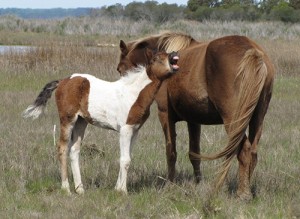
ASSATEAGUE — While it certainly isn’t the most glamorous aspect of managing the famed wild horses on Assateague, a biological technician is spending much of November conducting pregnancy tests on many of the mares on the barrier island in an attempt to predict how many if any new foals will join the herd in the coming year.
Assateague Island biological technician Allison Turner has been following as many as 29 mares in the population of wild horses on the barrier island waiting for them to defecate. The samples are collected, frozen and sent to a lab to be analyzed to determine if any of the mares will be expecting next spring.
There could be one or two new foals next spring, or as many as five or six, or possibly even zero. For two decades or more, Turner has been carefully monitoring the birthing habits of the island’s most famed residents and the information, more specifically the fecal matter, she collects this month will help tell the story for the next year.
“Although it is highly unlikely that all will be pregnant, 29 mares need to be tested, which involves locating and following each horse until she does her business,” said Assateague Island Alliance (AIA) Public Outreach Coordinator Ashlie Kozlowski this week. “Then a sample needs to be collected quickly before becoming decontaminated by another horse. The results aren’t determined by one or two pink lines within five minutes, but rather after being sent to a lab to be analyzed. We’ll have to wait until the end of January to find out which, if any, mares are expected to foal.”
Kozlowski said the pregnancy test process for the mares on Assateague is fairly primitive, but effective.
“There’s really not much scientific about it,” she said. “Allison knows the Maryland herd by their alpha-numeric names and their markings and she simply follows them until they do their business. There are 29 mares she is tracking to collect samples from.”
What is fairly scientific, however, is the complex contraceptive program administered on the wild horses on Assateague put in place several years ago to effectively reduce and manage the size of the herd. In the interest of managing the herd size, which, if left unchecked would overtake the barrier island and gobble up the very natural resources the animals need to survive, the National Park Service several years ago began an contraceptive program for the mares in the herd.
Selected mares are injected with a non-invasive contraceptive called PZP in an effort to prevent multiple births by the same mare in an effort to maintain and shrink the size of the herd to its manageable threshold. Assateague’s contraceptive program has become the model for wild horse and other animal management programs around the country.
As recently as just a few years ago, the size of the wild horse population on Assateague had swelled to around 140. Two new foals were birthed on the barrier island last year, which has been the trend in recent years.
“The trend recently has been one or two new foals a year, but it’s kind of a moving target,” said Kozlowski this week. “In previous years, there have been as many as five or six. That’s why we do these collections and testing now, so we know what to expect in the spring.”
In a typical year, the size of the population remains relatively constant with one or two new foals being born and older horses lost to attrition, old age, illness or other man-made or natural causes. From a high of about 140 just a few years ago, the number of wild horses on Assateague currently stands at an even 100, which is in the ideal target range of 80-100 for the barrier island.
“The goal has always been reducing the size of the herd, but now we’re at the adaptive management stage with a population of 100,” said Kozlowski. “We’ve gone from trying to reduce the size of the herd to holding steady around that 100 mark.”
Kozlowski said similar fecal collections and pregnancy tests conducted last winter resulted in only eight mares being administered, or “darted,” with the PZP contraceptive.
She said the number of mares treated each spring changes based on the test results.
“For example, if any of the mares we’re testing right now come back positive, they won’t be darted in the spring,” she said. “We only darted eight last spring and that is a relatively low number. After they birth one foal, they’re typically placed on the contraceptive. That allows us to stabilize and maintain the population, and it’s also healthy for the mares because of the strain of multiple births.”
Local residents and visitors will have the opportunity this weekend to find out more about the history of the famed Assateague horses and the contraceptive program. Author and photographer Jayne Silberman will be on hand at the visitor center on Saturday to sign copies of her book “Inside the Herd,” a photographic journey with the island’s wild horses.
The book signing will be held from 10 a.m. to 1 p.m. at the visitor’s center. In addition, Assateague Island National Seashore Science Communicator Kelly Taylor will make a presentation about the wild horses at 11 a.m. at the visitor’s center.
